Found on Flickr.
Red, orange, blue and green!
Dedicated to cicadas, the most amazing insects in the world.
Found on Flickr.
Red, orange, blue and green!
Thanks to David Emery for letting us know that the Bladder cicadas (Cystosoma saundersii) are out in Sydney Australia, and for providing this photo.
Badder cicadas are emerging down the Aussie east coast starting around the Queensland -NSW border on Sept 3 (FlickR) and we heard them for the first time on Sept 10 in Sydney. A photo of one captured on Sept 12 is attached to refresh Cicadamania devotees.
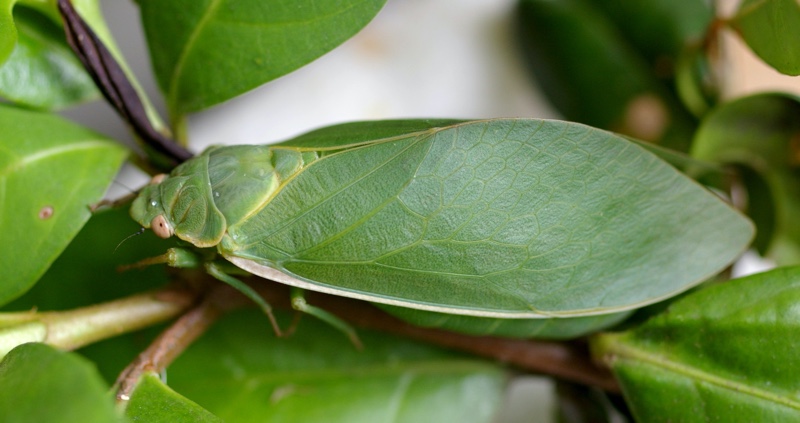
K is for Dr. Kritsky, specifically Dr. Gene Kritsky of the College of Mount St. Joseph in Cincinnati, Ohio.
Dr. Kritsky is one of the premier Magicicada experts and advocates; if you’re a cicada fan you must attend one of his lectures and buy one of his books. A few years ago Gene provided Cicada Mania with an interview.
Kikihia, one of the two major Genus of cicadas in New Zealand. David Marshall says: “The name Kikihia is derived from the Maori word for cicada, as is the name of the town Kihikihi, in New Zealand. You’ll love their public cicada statue. See this web page: http://en.wikipedia.org/wiki/Kihikihi“.
The Kobonga is a Genus of cicadae that exists in eastern Australia. Thanks to David Marshall and Kathy Hill of InsectSingers.com for these wonderful photos of a Kobonga species currently nicknamed the Xmas Clanger (species name pending).
G is for Greengrocer. The Greengrocer is the green morph of the Australian cicada Cyclochila australasiae. These cicadas can be found in south-eastern Australia. They have a large pronotal collar, and if you use your imagination, it looks like they’re wearing a tiny Pith helmet above their eyes.
Here’s a close of up of a Greengrocer (from Bron):
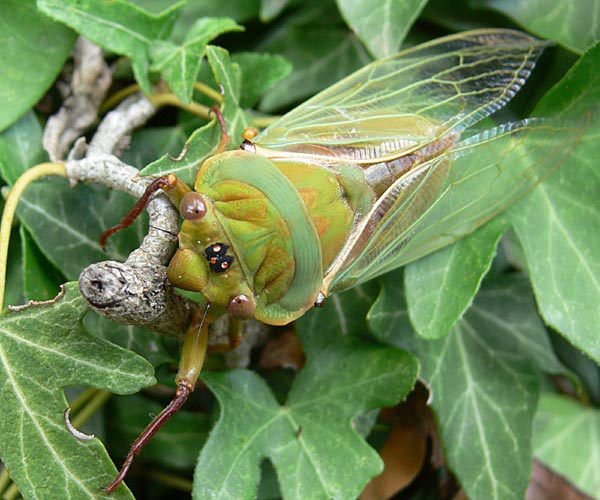
Here’s a box of Greengrocers (from Kevin Lee):
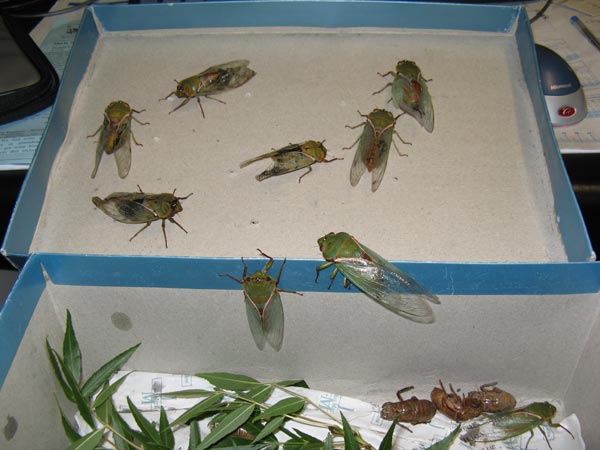
David Emery emailed us this amazing photo of Anapsaltoda pulchra cicadas. Anapsaltoda pulchra are also known as Golden Emperors. These cicadas are from Herberton, Queensland, Australia.
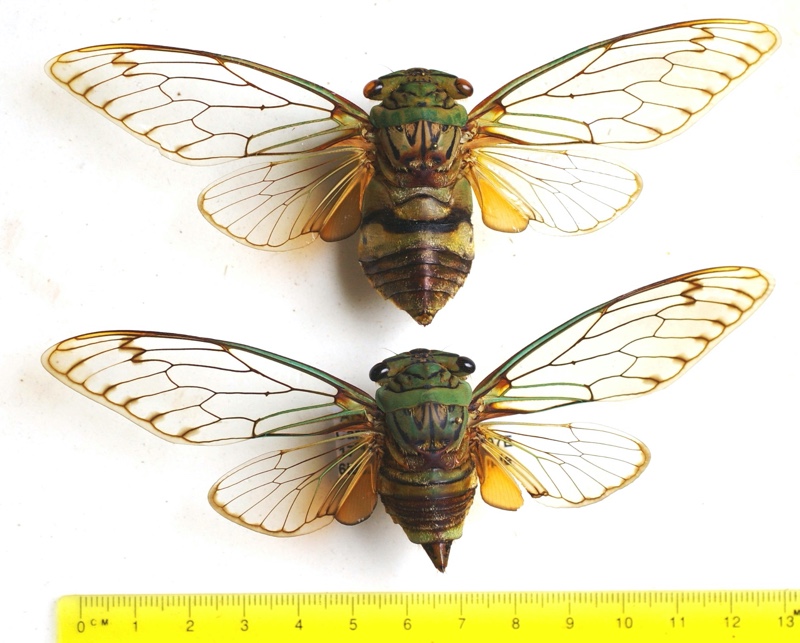
Scientific classification:
Family: Cicadidae
Subfamily: Cicadinae
Tribe: Psaltodini
SubTribe: ?
Genus: Anapsaltoda
Species: Anapsaltoda pulchra (Ashton, 1921)
Tribe (Psaltodini) information comes from: MARSHALL, DAVID C. et al.A molecular phylogeny of the cicadas (Hemiptera: Cicadidae) with a review of tribe and subfamily classification.Zootaxa, [S.l.], v. 4424, n. 1, p. 1—64, may 2018. ISSN 1175-5334. Available at: https://www.biotaxa.org/Zootaxa/article/view/zootaxa.4424.1.1
David Emery send us a photo of a Cystosoma saundersii (bladder cicada) from Australia and we added it to the gallery.
Just to complement the Aussie cicadas, a small colony of these Cystosoma saundersii have been droning and rattling at dusk around Burwoood in Sydney for the past 2 months. This is their southern-most extension down the east coast of Australia.
cheers,
David.
Click the link above or the image below to access large versions of the image.

More information about Cystosoma saundersii on the CSIRO site.
The Bladder Cicada can be sound in eastern Queensland & NSW, and are most common Nov-Jan. (Moulds, M.S.. Australian Cicadas Kennsignton: New South Wales Press, 1990, p. 193.)
Here’s a photo of a diseased specimen:
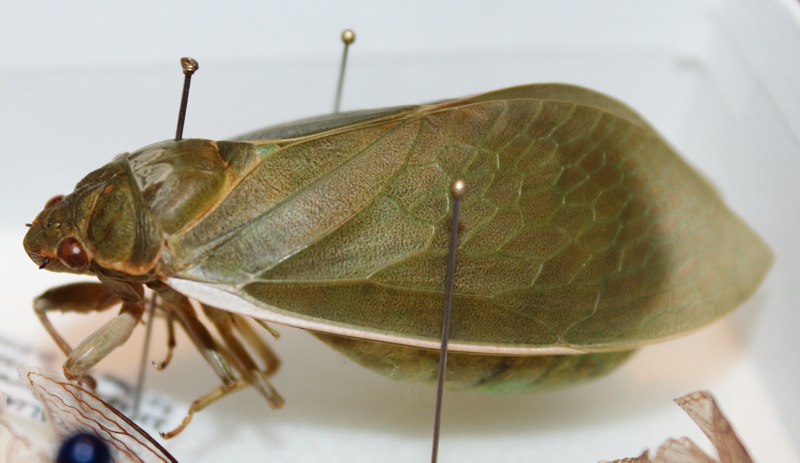
Found this on Flickr. Is this the same species as the latest mystery cicada? Thanks to David Emery for the tip.
Can you identify this Australian cicada??? The photo was take by Elizabeth Barnett.
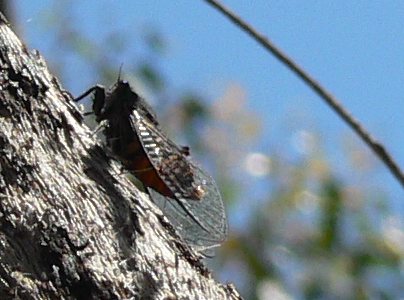
Hi, I wondered whether you can help me identify a cicada we saw at Hall’s Gap (Midwest Victoria, Australia) in January this year? It had a limited tolerance for being photographed and took off asap. From memory its call was a sort of short “eck! eck!” rather than the continuous shrill you get from a greengrocer. There were heaps of them calling but this was the only one we saw. I’d estimate it was about half the size of a greengrocer.
I asked David Emery, and he said:
Looks pretty close to Pauropsalta mneme (Alarm clock ticker) with the orange belly and wing infuscations and is in the right place! Heard the first C.celis around Sydney last week, but very dry at present.
After a Google search for Pauropsalta mneme I’d say David was correct.
The Pauropsalta mneme can be found in south-eastern NSW, Victoria, and a small pocket in South Australia, from late September to early January. (Moulds, M.S.. Australian Cicadas Kennsignton: New South Wales Press, 1990, p. 131.)
This is a photo of the amazing Bagpipe cicada (Lembeja paradoxa) was taken by Timothy Emery (David Emery’s son).
Attached is a photo taken by my son, Timothy Emery from Thursday Island, Torres Strait off Cape York, Queensland. This a male “bagpipe cicada” (Lembeja paradoxa) singing for his female. These guys at rest look like dead leaves with wings folded under stems of grass, but when singing at dusk, rush up the stems and can expand their abdomens incredibly up to 5-10 x resting size (hence the bagpipe bit) and emit a very loud droning sound for their size. A great emergence of these on Thursday Island in the first 2 weeks of January.
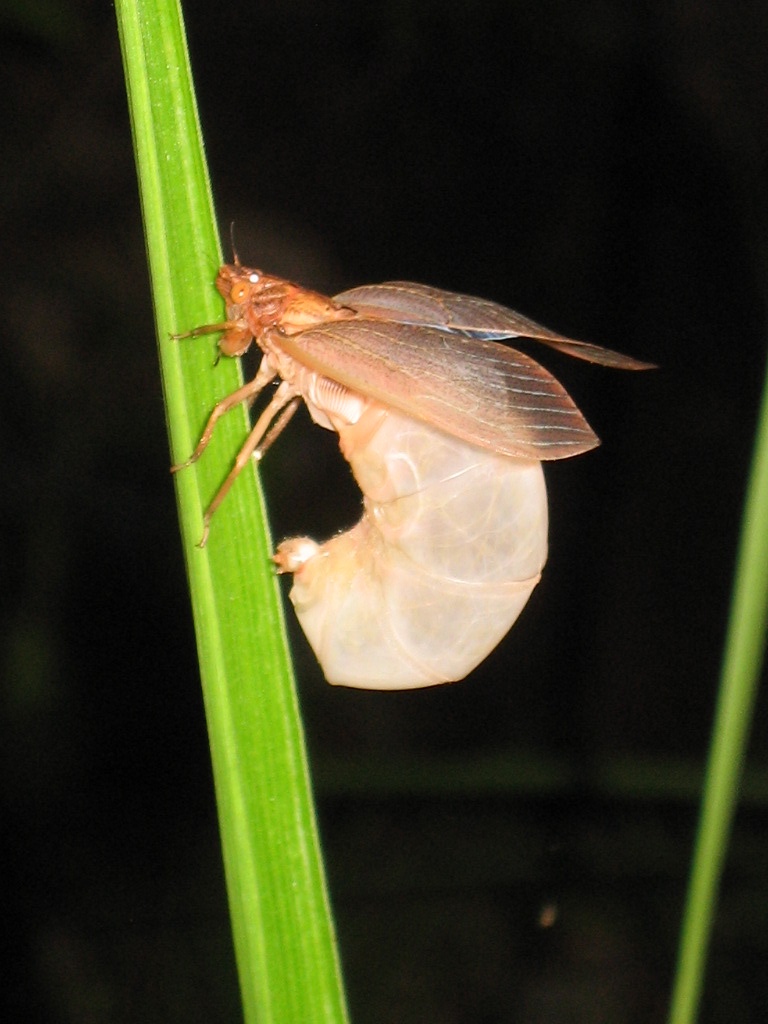
The Bagpipe cicada can be found in the Northern tip of Queensland, from October to February, but they’re most common during January. (Moulds, M.S.. Australian Cicadas Kennsignton: New South Wales Press, 1990, p. 178)
David Marshall and Kathy Hill have discovered that a particular species of katydid mimics the wing-flick of female cicadas to lure male cicadas to their certain doom.
We have found that predatory Chlorobalius leucoviridis katydids (Orthoptera: Tettigoniidae) can attract male cicadas (Hemiptera: Cicadidae) by imitating the species-specific wing-flick replies of sexually receptive female cicadas. This aggressive mimicry is accomplished both acoustically, with tegminal clicks, and visually, with synchronized body jerks. Remarkably, the katydids respond effectively to a variety of complex, species-specific Cicadettini songs, including songs of many cicada species that the predator has never encountered.
Read the entire research article: Versatile Aggressive Mimicry of Cicadas by an Australian Predatory Katydid.